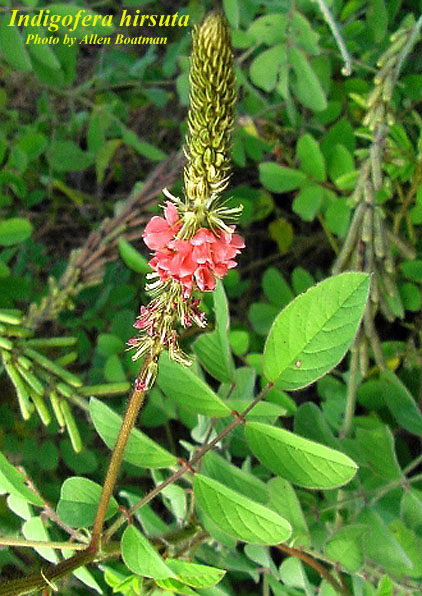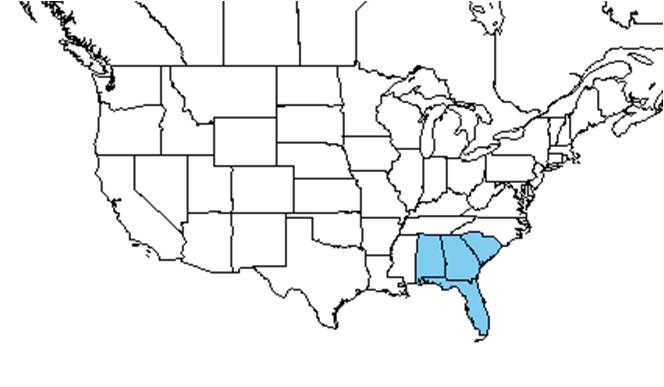Difference between revisions of "Indigofera hirsuta"
HaleighJoM (talk | contribs) (→Ecology) |
|||
| (10 intermediate revisions by 6 users not shown) | |||
| Line 3: | Line 3: | ||
{{taxobox | {{taxobox | ||
| name = Indigofera hirsuta | | name = Indigofera hirsuta | ||
| − | | image = | + | | image = Indi_hirs.jpg |
| − | | image_caption = | + | | image_caption = Photo by Allen Boatman, [http://www.florida.plantatlas.usf.edu/Default.aspx Atlas of Florida Vascular Plants] |
| regnum = Plantae | | regnum = Plantae | ||
| divisio = Magnoliophyta - Flowering plants | | divisio = Magnoliophyta - Flowering plants | ||
| Line 17: | Line 17: | ||
| range_map_caption = Natural range of ''Indigofera hirsuta'' from USDA NRCS [http://www.plants.usda.gov Plants Database]. | | range_map_caption = Natural range of ''Indigofera hirsuta'' from USDA NRCS [http://www.plants.usda.gov Plants Database]. | ||
}} | }} | ||
| + | |||
| + | Common name: Hairy indigo<ref name="weakley">Weakley, A.S. 2015. Flora of the southern and mid-atlantic states. Working Draft of 21 May 2015. University of North Carolina at Chapel Hill, Chapel Hill, North Carolina.</ref> | ||
| + | ==Taxonomic notes== | ||
| + | Synonyms: none.<ref name="weakley">Weakley, A.S. 2015. Flora of the southern and mid-atlantic states. Working Draft of 21 May 2015. University of North Carolina at Chapel Hill, Chapel Hill, North Carolina.</ref> | ||
| + | |||
| + | Varieties: none.<ref name="weakley">Weakley, A.S. 2015. Flora of the southern and mid-atlantic states. Working Draft of 21 May 2015. University of North Carolina at Chapel Hill, Chapel Hill, North Carolina.</ref> | ||
==Description== | ==Description== | ||
<!-- Basic life history facts such as annual/perrenial, monoecious/dioecious, root morphology, seed type, etc. --> | <!-- Basic life history facts such as annual/perrenial, monoecious/dioecious, root morphology, seed type, etc. --> | ||
| − | |||
==Distribution== | ==Distribution== | ||
| + | This plant is scattered throughout the Southeast, including areas like southern Mississippi and Alabama.<ref name="weakley">Weakley, A.S. 2015. Flora of the southern and mid-atlantic states. Working Draft of 21 May 2015. University of North Carolina at Chapel Hill, Chapel Hill, North Carolina.</ref> | ||
==Ecology== | ==Ecology== | ||
| − | ===Habitat=== <!--Natural communities, human disturbed habitats, topography, hydrology, soils, light, fire regime requirements for removal of competition, etc.--> | + | ===Habitat=== |
| + | ''Indigofera hirsuta'' frequents sandy disturbed areas, such as wildlife "food fields". It is native to the Old World tropics.<ref name="weakley">Weakley, A.S. 2015. Flora of the southern and mid-atlantic states. Working Draft of 21 May 2015. University of North Carolina at Chapel Hill, Chapel Hill, North Carolina.</ref><!--Natural communities, human disturbed habitats, topography, hydrology, soils, light, fire regime requirements for removal of competition, etc.--> | ||
===Phenology=== <!--Timing off flowering, fruiting, seed dispersal, and environmental triggers. Cite PanFlora website if appropriate: http://www.gilnelson.com/PanFlora/ --> | ===Phenology=== <!--Timing off flowering, fruiting, seed dispersal, and environmental triggers. Cite PanFlora website if appropriate: http://www.gilnelson.com/PanFlora/ --> | ||
| − | ===Seed dispersal=== | + | It flowers from September to December with peak inflorescence in September.<ref>Nelson, G. [http://www.gilnelson.com/ PanFlora]: Plant data for the eastern United States with emphasis on the Southeastern Coastal Plains, Florida, and the Florida Panhandle. www.gilnelson.com/PanFlora/ Accessed: 12 DEC 2016</ref> |
| − | ===Seed bank and germination=== | + | <!--===Seed dispersal===--> |
| − | ===Fire ecology=== <!--Fire tolerance, fire dependence, adaptive fire responses--> | + | <!--===Seed bank and germination===--> |
| + | <!--===Fire ecology===--> <!--Fire tolerance, fire dependence, adaptive fire responses--> | ||
===Pollination=== | ===Pollination=== | ||
| − | + | The following Hymenoptera families and species were observed visiting flowers of ''Indigofera hirsuta'' at Archbold Biological Station:<ref name="Deyrup 2015">Deyrup, M.A. and N.D. 2015. Database of observations of Hymenoptera visitations to flowers of plants on Archbold Biological Station, Florida, USA.</ref> | |
| − | |||
| − | |||
| − | |||
| − | |||
| − | |||
| − | |||
| − | |||
| − | |||
| − | Megachilidae: Megachile exilis parexilis | + | Megachilidae: ''Anthidiellum notatum rufomaculatum, A. perplexum, Megachile albitarsis, M. brevis pseudobrevis, M. exilis parexilis, M. mendica, M. petulans'' |
| − | + | <!--===Herbivory and toxicology===--> <!--Herbivory, granivory, insect hosting, etc.--> | |
| + | <!--===Diseases and parasites===--> | ||
| − | + | ==Conservation, cultivation, and restoration== | |
| − | == | + | ==Cultural use== |
| − | |||
| − | |||
| − | |||
==Photo Gallery== | ==Photo Gallery== | ||
==References and notes== | ==References and notes== | ||
Latest revision as of 11:25, 13 July 2022
| Indigofera hirsuta | |
|---|---|

| |
| Photo by Allen Boatman, Atlas of Florida Vascular Plants | |
| Scientific classification | |
| Kingdom: | Plantae |
| Division: | Magnoliophyta - Flowering plants |
| Class: | Magnoliopsida - Dicotyledons |
| Order: | Fabales |
| Family: | Fabaceae ⁄ Leguminosae |
| Genus: | Indigofera |
| Species: | I. hirsuta |
| Binomial name | |
| Indigofera hirsuta L. | |

| |
| Natural range of Indigofera hirsuta from USDA NRCS Plants Database. | |
Common name: Hairy indigo[1]
Contents
Taxonomic notes
Synonyms: none.[1]
Varieties: none.[1]
Description
Distribution
This plant is scattered throughout the Southeast, including areas like southern Mississippi and Alabama.[1]
Ecology
Habitat
Indigofera hirsuta frequents sandy disturbed areas, such as wildlife "food fields". It is native to the Old World tropics.[1]
Phenology
It flowers from September to December with peak inflorescence in September.[2]
Pollination
The following Hymenoptera families and species were observed visiting flowers of Indigofera hirsuta at Archbold Biological Station:[3]
Megachilidae: Anthidiellum notatum rufomaculatum, A. perplexum, Megachile albitarsis, M. brevis pseudobrevis, M. exilis parexilis, M. mendica, M. petulans
Conservation, cultivation, and restoration
Cultural use
Photo Gallery
References and notes
- ↑ 1.0 1.1 1.2 1.3 1.4 Weakley, A.S. 2015. Flora of the southern and mid-atlantic states. Working Draft of 21 May 2015. University of North Carolina at Chapel Hill, Chapel Hill, North Carolina.
- ↑ Nelson, G. PanFlora: Plant data for the eastern United States with emphasis on the Southeastern Coastal Plains, Florida, and the Florida Panhandle. www.gilnelson.com/PanFlora/ Accessed: 12 DEC 2016
- ↑ Deyrup, M.A. and N.D. 2015. Database of observations of Hymenoptera visitations to flowers of plants on Archbold Biological Station, Florida, USA.